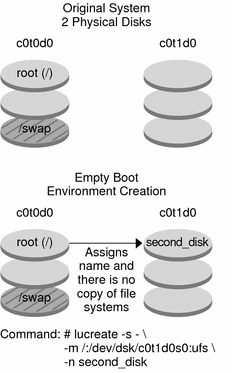Example of Creating an Empty Boot Environment and Installing a Solaris Flash Archive (Command-Line Interface)
The following procedures cover the three-step process:
-
Creating the empty boot environment
-
Installing the archive
-
Activating the boot environment which then becomes the currently running boot environment.
The lucreate command creates a boot environment that is based on the file systems in the active boot environment. When you use the lucreate command with the -s - option, lucreate quickly creates an empty boot environment. The slices are reserved for the file systems specified, but no file systems are copied. The boot environment is named, but not actually created until installed with a Solaris Flash archive. When the empty boot environment is installed with an archive, file systems are installed on the reserved slices. The boot environment is then activated.
To Create an Empty Boot Environment
In this first step, an empty boot environment is created. Slices are reserved for the file systems that are specified, but no copy of file systems from the current boot environment occurs. The new boot environment is named second_disk.
# lucreate -s - -m /:/dev/dsk/c0t1d0s0:ufs \ -n second_disk |
The boot environment is ready to be populated with a Solaris Flash archive.
Figure 12–3 shows the creation of an empty boot environment.
Figure 12–3 Creating an Empty Boot Environment

To Install a Solaris Flash Archive on the New Boot Environment
In this second step, an archive is installed on the second_disk boot environment that was created in the previous example. The archive is located on the local system. The operating system versions for the -s and -a options are both Solaris 10 releases. The archive is named Solaris_10.flar.
# luupgrade -f -n second_disk \ -s /net/installmachine/export/Solaris_10/OS_image \ -a /net/server/archive/Solaris_10.flar |
The boot environment is ready to be activated.
To Activate the New Boot Environment
In this last step, the second_disk boot environment is made bootable with the luactivate command. The system is then rebooted and second_disk becomes the active boot environment.
# luactivate second_disk # init 6 |
-
For step-by-step information about creating an empty boot environment, see To Create an Empty Boot Environment for a Solaris Flash Archive (Command-Line Interface).
-
For step-by-step information about creating a Solaris Flash archive, see Chapter 3, Creating Solaris Flash Archives (Tasks), in Solaris 10 Installation Guide: Solaris Flash Archives (Creation and Installation).
-
For step-by-step information about activating a boot environment or falling back to the original boot environment, see Chapter 10, Failure Recovery: Falling Back to the Original Boot Environment (Tasks).
- © 2010, Oracle Corporation and/or its affiliates
